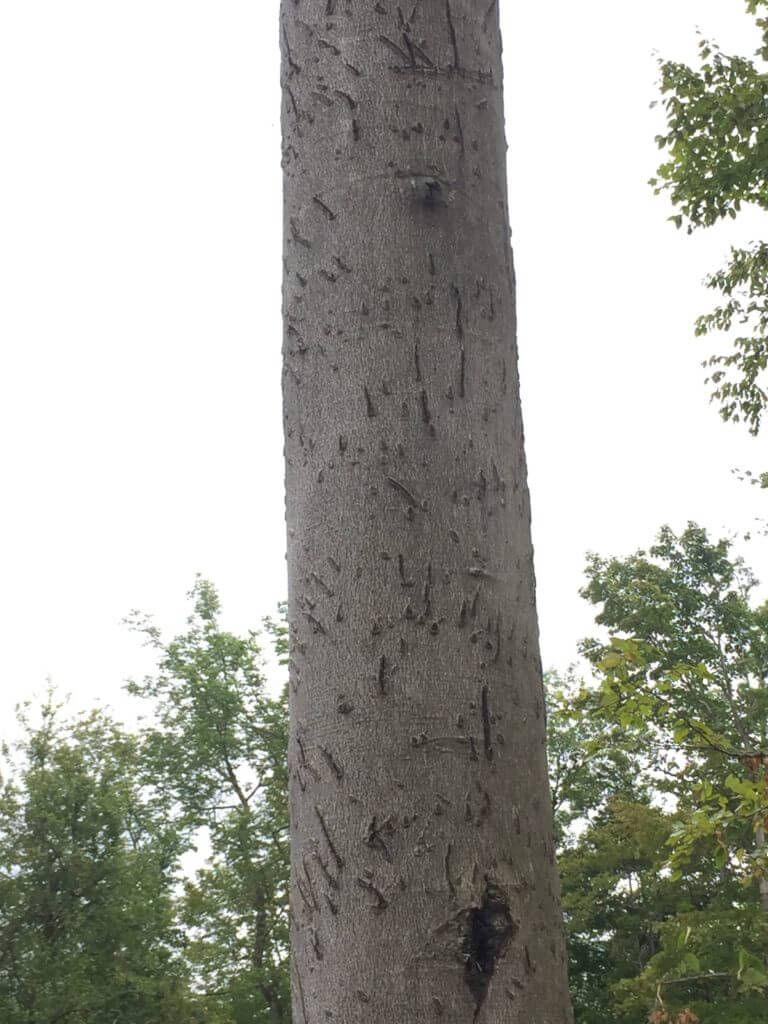Into the Woods: American Beech Profile

Among foresters, American beech (Fagus grandifolia) is a common source of consternation. It is often considered a low-value, low-quality “weed,” outcompeting other tree species and taking over the forest’s understory. Some foresters interested in maintaining diversity, increasing forest health and growing more commercial tree species have adopted special practices just to avoid regenerating beech, including treating cut beech stumps with herbicide.
To the layperson, this may seem a little extreme. Healthy beech trees are beautiful, with smooth gray “elephant skin” bark. A grove of large beech trees has a high, arching canopy, casting green-tinged light on everything below. Beechnuts are also a valuable source of food for wildlife, prized by black bear, turkey and deer, among many others. The wood, while not much good for lumber, is decent firewood.
So what’s the problem?
Beech was dominant in Vermont’s pre-settlement forests, comprising about 40 percent of the trees across New England. It is “shade-tolerant,” meaning that it can grow under dense canopies with very little light. Shade-tolerant trees dominate undisturbed forests over time; they grow in the understory, waiting for less-tolerant species to decline, at which point they take over. The pre-settlement forests of Vermont experienced major disturbances infrequently (by modern standards), which created great conditions for growing beech and other shade-tolerant species such as hemlock and red spruce.
About 80 percent of Vermont’s forests were cleared for agriculture in the early-to-mid 1800s, eliminating much of our old-growth beech. When this agricultural land was abandoned and allowed to succeed to forest, conditions favored fast-growing, shade-intolerant tree species, such as white pine, white birch and aspen.
In 1920, just as much of Vermont was beginning to revert back to forest, a new threat to beech was discovered in Nova Scotia. Beech bark disease (BBD), also known as the “beech blight,” quickly spread throughout Vermont. BBD is a disease “complex,” the combination of an exotic scale insect and two species of fungi in the genus Neonectria. It manifests itself in the bark of beech trees, which becomes mottled with black lesions and bumps. Most infected beech trees can still reach a reproductive age but are killed by the disease before they become very large or old. Beech are thought to be able to live for 400-600 years, but today I rarely see one older than 60 to 80. While some beech trees show resistance to BBD, maintaining relatively smooth bark, they are uncommon.
When beech trees are stressed (as they are when they have BBD) their root systems produce sprouts, and so the understories of forests with BBD-infected beech are often dominated by a near-monoculture of beech saplings. These sprouts are equipped with an established root system, allowing them to outcompete young trees of other species, and are genetically identical to the parent tree, making them equally susceptible to BBD. As if that weren’t enough, beech is one of a white-tailed deer’s least favorite foods; due to over-browsing by deer in many areas of Vermont, other tree species get eaten, but beech is left alone.
All of these factors explain why beech is branded a “weed.” In many forests the presence of beech means a less healthy, diverse understory and overstory, both dominated by a species which is diseased, low-value and skilled at sprouting, good at outcompeting young trees of other species but unable to grow into healthy, mature trees.
Vermont’s forests have endured a number of exotic pests and pathogens since European settlement: the American chestnut blight, Dutch elm disease, butternut canker, blister rust, the approaching hemlock wooly adelgid and emerald ash borer. The list goes on. In each of these examples, a pest or pathogen introduced by humans leads to the loss of a tree species or the fundamental alteration of its behavior. These changes reverberate throughout our forested ecosystems, causing unpredictable problems for our native flora and fauna.
For these reasons, our long-term goal should be to reestablish beech as a healthy part of our forests. While BBD-infected beech trees may be cut, encourage the growth of BBD-resistant beech trees wherever they are found. This can be done by allowing any healthy, smooth-barked beech trees to continue to grow, and even by thinning around them. With good management, and given enough time, I think we stand a chance of reestablishing beech as a healthy piece of our forested ecosystems.
Ethan Tapper is the Chittenden County forester. He can be reached via email, by phone at (802) 585-9099, or at his office at 111 West Street, Essex Junction.

